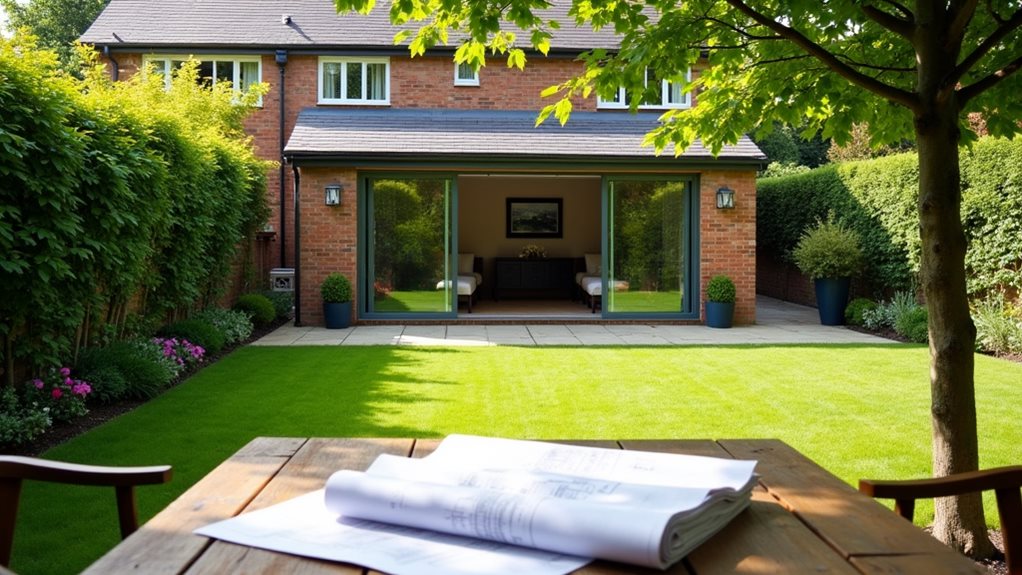Phone:
(701)814-6992
Physical address:
6296 Donnelly Plaza
Ratkeville, Bahamas.

Before starting your home extension project in Manchester, discover essential planning permission insights that could save you time and hassle.
When you're planning a home extension in Manchester, it's crucial to grasp the planning permission requirements. Most smaller projects, like single-storey extensions, usually fall under permitted development, meaning you might skip formal permissions if you stay within limits. However, double-storey or larger extensions will typically require approval. Be sure to check local regulations, as certain property types, such as flats or listed buildings, may have restrictions. Preparing detailed plans and considering neighbor feedback can ease your approval process. You'll find that understanding these facets can greatly streamline your project, leading to more enjoyable outcomes as you move forward.

Understanding planning permissions is essential when considering a home extension. You might dream of expanding your living space, but managing planning restrictions can be tricky. It's crucial to know whether your project falls under permitted development or if you'll need formal planning permission.
For instance, if your proposed extension exceeds certain heights or takes up too much ground space, you'll definitely need permission. Many homeowners also find it beneficial to consult with local builders to navigate these requirements effectively.
If your home is a flat, maisonette, or sits in a conservation area, things get even more complicated, as these types of properties typically lack permitted development rights. Make sure you're aware of how your extension will affect your outdoor space; after all, it can't occupy more than half of your garden.
When you're ready to apply, gather detailed plans and submit them to your local council. They'll review your application, notify your neighbors, and aim to reach a decision within eight weeks. It's also important to consider that neighbours' rights may be affected by your extension, which could lead to legal considerations.
If things don't go your way, no worries—you can amend and resubmit your plans within a year or appeal the decision. By understanding these guidelines, you can feel confident moving forward with your home extension journey while remaining within the necessary legal frameworks.
When considering a home extension, you have several types to choose from, each offering unique benefits and design possibilities.
Single storey extensions are popular for expanding ground floor space, perfect for larger kitchens or open-plan living areas. They're generally more straightforward, with permitted development allowing extensions up to six metres without planning permission. Moreover, these extensions typically enhance property value significantly.
If you need more substantial space, consider double storey extensions. These add significant room over two floors, ideal for extra bedrooms or bathrooms, although they typically require planning permission.
Want something more versatile? Wrap around extensions combine rear and side extensions, creating spacious, flexible layouts. They make the most of your property while ensuring your outdoor space remains intact, though planning permission might be necessary if you exceed certain limits.
Lastly, rear extensions expand the back of your home without altering its front appearance. These are particularly well-suited for enhancing kitchens and family rooms, often fitting within permitted development rules.
Ultimately, choosing the right type of extension depends on your specific needs, the space available, and how you envision your home evolving.

Planning a home extension in Manchester involves maneuvering a variety of key regulations that dictate what you can and can't do. Familiarizing yourself with these rules isn't just a formality; it's crucial for a successful project.
Here are three critical areas to take into account:
Understanding these local regulations guarantees you're in alignment with governing bodies and helps you avoid setbacks.
Keep in mind that materials must match your existing house, and certain features, like balconies and verandas, aren't allowed.
Engaging with neighbors and seeking pre-application advice can make the process smoother.
The application process for your home extension can feel challenging, but breaking it down into manageable steps makes it more straightforward.
First, check if you need planning permission. If your extension exceeds specific limits or involves certain property types, it's vital. Consulting with an architect can help you navigate building regulations and guarantee compliance with local guidelines.
Once you're ready to submit, gather your plans, fill out the necessary forms, and prepare supporting documents. Access the Planning Portal to guide your selection of the correct application forms, making sure you include any required fees, which aid in processing your application.
The local planning authority (LPA) will validate your submission, acknowledging receipt and starting the application timeline.
What happens next? Expect public notifications, which include postings in local newspapers and outreach to neighboring properties. The LPA will consult relevant stakeholders before making a decision.
Typically, you can expect a resolution within eight weeks. Remember to stay updated, as application details are made available online. By keeping track of these steps and adhering to submission requirements, you'll feel more confident throughout the process.

Successfully steering through the application process for your home extension hinges on understanding specific requirements and preparing your submission carefully.
To increase your chances of success, consider these application tips:
Be mindful of size restrictions and materials that need to match existing structures.
In your journey toward that dream extension, think of planning permissions as the sturdy foundation of your home—essential for support and longevity. By grasping the types of extensions and key regulations in Manchester, you'll pave the way for a smoother application process. Armed with the right tips, you won't just build out; you'll build up your dreams. So, embrace this chance to enhance your living space, and watch as your vision transforms into a beautiful reality.